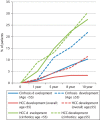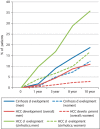Rates of cirrhosis and hepatocellular carcinoma in chronic hepatitis B and the role of surveillance: a 10-year follow-up of 673 patients
- PMID: 25831135
- PMCID: PMC4415961
- DOI: 10.1097/MEG.0000000000000341
Rates of cirrhosis and hepatocellular carcinoma in chronic hepatitis B and the role of surveillance: a 10-year follow-up of 673 patients
Abstract
Background and objectives: Development of cirrhosis and hepatocellular carcinoma (HCC) are critical milestones in the natural history of chronic hepatitis B virus (HBV) infection. There are no prospective data on the risk of these critical milestones in HBV patients in Singapore. The efficacy and justification of HCC surveillance is determined by the rate of HCC development. Our study aims to determine the rates of cirrhosis and HCC in HBV patients in Singapore and hence the appropriateness of HCC surveillance.
Materials and methods: A total of 673 HBV patients were enrolled between March 2003 and March 2004 and followed up for 10 years with regular surveillance for HCC using α-fetoprotein and abdominal ultrasound.
Results: Overall, 62.6% of the patients were men, mean age 56.4 years. In all, 31% were hepatitis B e antigen-positive and 14.9% had cirrhosis at baseline. Seventy-four patients developed cirrhosis and 42 patients developed HCC after 10 years. The overall 10-year incidence of cirrhosis and HCC was 16.2% (1.6%/year) and 7.8% (0.8%/year), respectively. The overall incidence of HCC in cirrhotics was 29.7% (3.0%/year), highest within a year of diagnosis of cirrhosis (7.9%). The rate of cirrhosis was significantly higher in those aged more than 55 years (P=0.001). Sex and hepatitis B e antigen status did not affect the rate of cirrhosis. Factors with significantly higher overall rates of HCC were age 55 years or more (P=0.001), male sex (P=0.001), and baseline α-fetoprotein of 4.1 µg/l or more (P<0.0001). However, age more than 55 years was not significant in the development of HCC in cirrhotics.
Conclusion: The rate of cirrhosis in HBV patients in Singapore is about 1.6% per year. The rate of HCC is about 0.8% per year overall and 3.0% per year in cirrhotics, which justifies HCC surveillance.
Figures




Comment in
-
Rates of cirrhosis and hepatocellular carcinoma in chronic hepatitis B and the role of surveillance: a 10-year follow-up of 673 patients.Eur J Gastroenterol Hepatol. 2015 Oct;27(10):1230. doi: 10.1097/MEG.0000000000000426. Eur J Gastroenterol Hepatol. 2015. PMID: 26327502 No abstract available.
References
-
- Hepatitis B: World Health Organization Fact Sheet 204. 2000: World Health Organization. Available at: http://www.who.int/mediacentre/factsheets/fs204/en/. [Accessed 26 November 2013].
-
- Chen CJ, Wang LY, Yu MW. Epidemiology of hepatitis B virus infection in the Asia–Pacific region. J Gastroenterol Hepatol 2000; 15 (Suppl):E3–E6. - PubMed
-
- Li J, Wong GW, Chang J. Epidemiology of patients with liver cirrhosis in a single tertiary centre in Singapore [abstract PP596]. Hepatol Int 2010; 4:261–262.
-
- Hui AY, Chan HL, Leung NW, Hung LC, Chan FK, Sung JJ. Survival and prognostic indicators in patients with hepatitis B virus-related cirrhosis after onset of hepatic decompensation. J Clin Gastroenterol 2002; 34:569–572. - PubMed
-
- Ong SC, Lim SG, Li SC. How big is the financial burden of hepatitis B to society? A cost-of-illness study of hepatitis B infection in Singapore. J Viral Hepat 2009; 16:53–63. - PubMed

